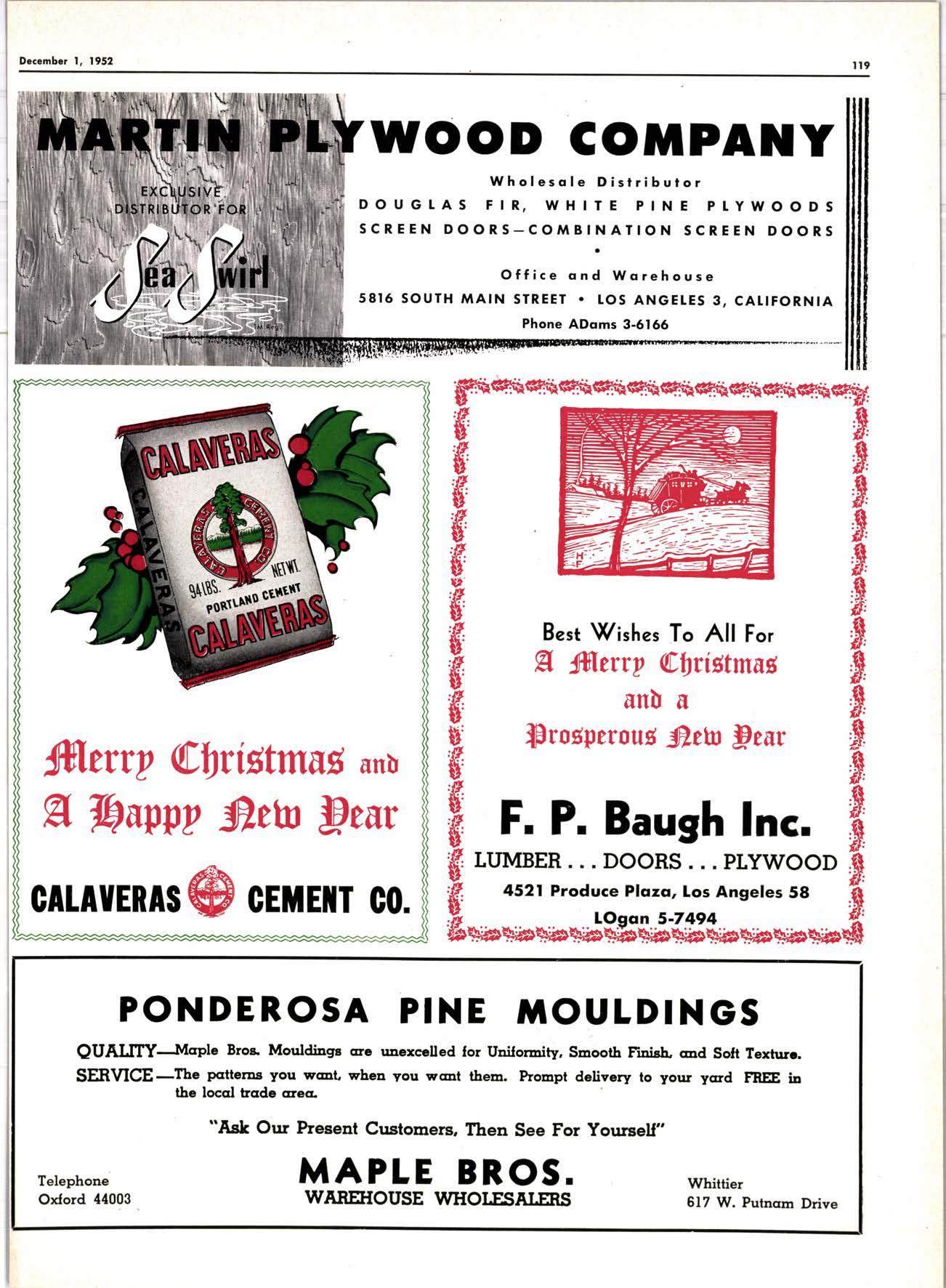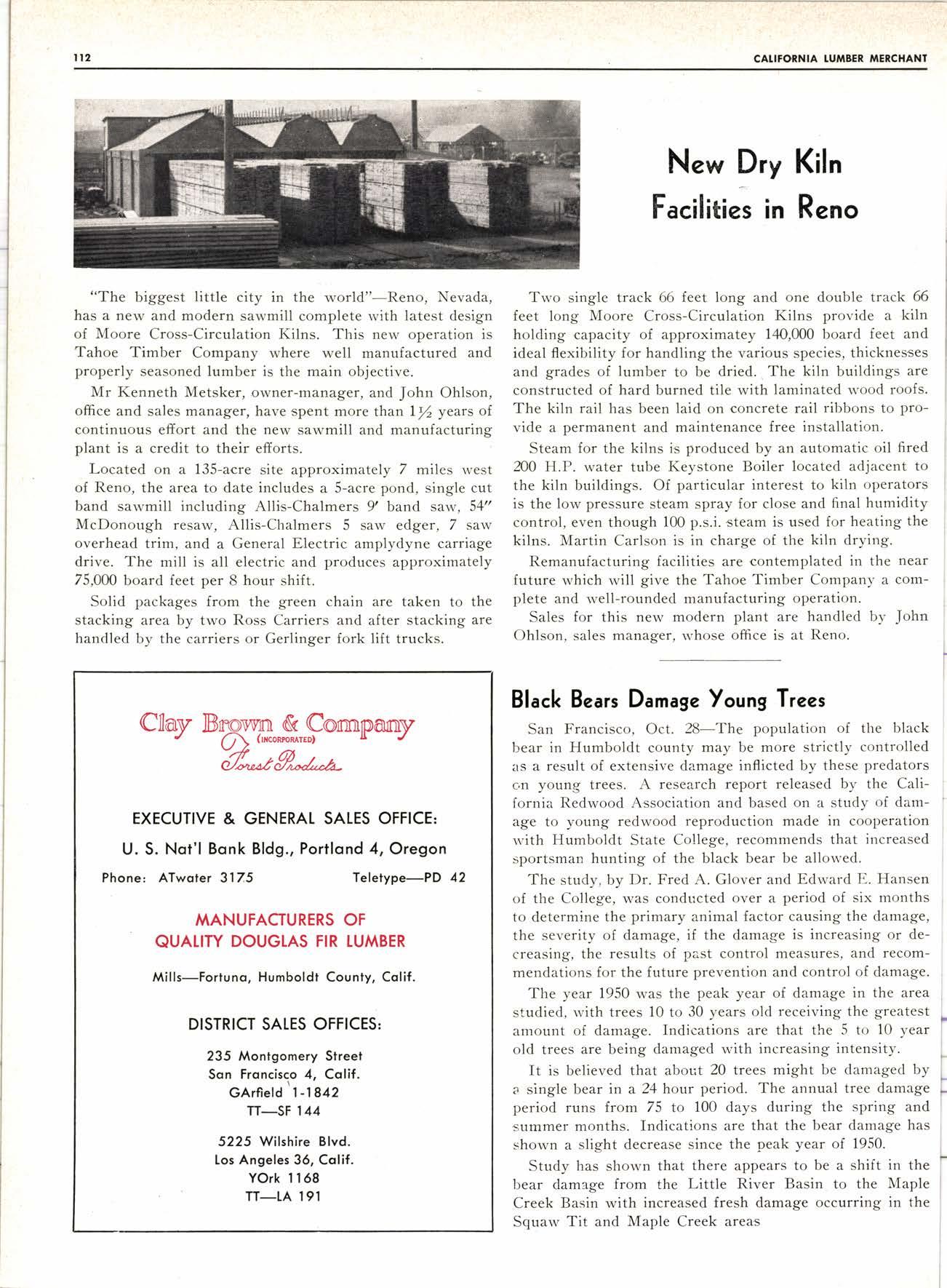
9 minute read
New Dry Kiln
Facilities in Reno
Two single track 66 feet long and one double track 66 feet long Moore Cross-Circulation Kilns provide a kiln holding capacity of approximatey 14O,000 board feet and ideal flexibility for handling the various species, thicknesses and grades of lumber to be dried. The kiln buildings are constructed of hard burned tile with laminated wood roofs. The kiln rail has been laid on €oncrete rail ribbons to provide a permanent and maintenance free installation.
Steam for the kilns is produced by an automatic oil fired 200 H.P. water tube Keystone Boiler located adjacent to the kiln buildings. Of particular interest to kiln operators is the low pressure steam spray for close and final humidity control, even though 100 p.s.i. steam is used for heating the kilns. Martin Carlson is in charge of the kiln drying.
Remanufacturing facilities are contemplated in the near future which will give the Tahoe Timber Company a complete and well-rounded manufacturing operation.
Sales for this new modern plant are handled by John Ohlson, sales manager, rvhose office is at Reno.
Bfack Bears Damage Young Trees
EXECUTIVE & GENERAT SALES OFFICE:
U. S. Not'l Bonk Bldg., Portlond 4, Oregon
Phone: ATwoter 3125
Teletype-PD 42
MANUFACTURERS OF QUATITY DOUGTAS FIR LUMBER
Mills-Fortuno, Humboldt County, Colif.
DISTRICT SATES OFFICES, 235 Montgomery Streel Son Froncisco 4, Colif.
GArfield '1-'t842
TT_SF I44
5225 Wilshire Blvd.
Los Angeles 36, Colif.
YOrk 1 168
TT-IA l9l
San Francisco, Oct. 8-The population of the black bear in Humboldt county may be more strictly controlled as a result of extensive damage inflicted by these predators c,n young trees. A research report released by the California Redwood Association and based on a study of damage to young redwood reproduction made in cooperation r.vith Humboldt State College, recommends that increased sportsman hunting of the black bear be allowed.
The study, by Dr. Fred A. Glover and Edward E. Hansen of the College, was condttcted over a period of six months to determine the primary animal factor causing the damage, the severity of damage, if the damage is increasing or decreasing, the results of past control measures, and recommendations for the future prevention and control of damage.
The year 1950 was the peak year of damage in the area studied, 'r,vith trees 10 to 30 years old receiving the greatest amount of damage. Indications are that the 5 to 10 year old trees are being damaged with increasing intensity.
It is believed that about 2O trees might be damaged by a single bear in a 24 hour period. The annual tree damage period runs from 75 to 100 days during the spring and summer months. Indications are that the bear damage has -.hown a slight decrease since the Deak year of 1950.
Study has shown that there appears to be a shift in the bear damage from the Little River Basin to the Maple Creek Basin with increased fresh damage occurring in the Squaw Tit and Maple Creek areas
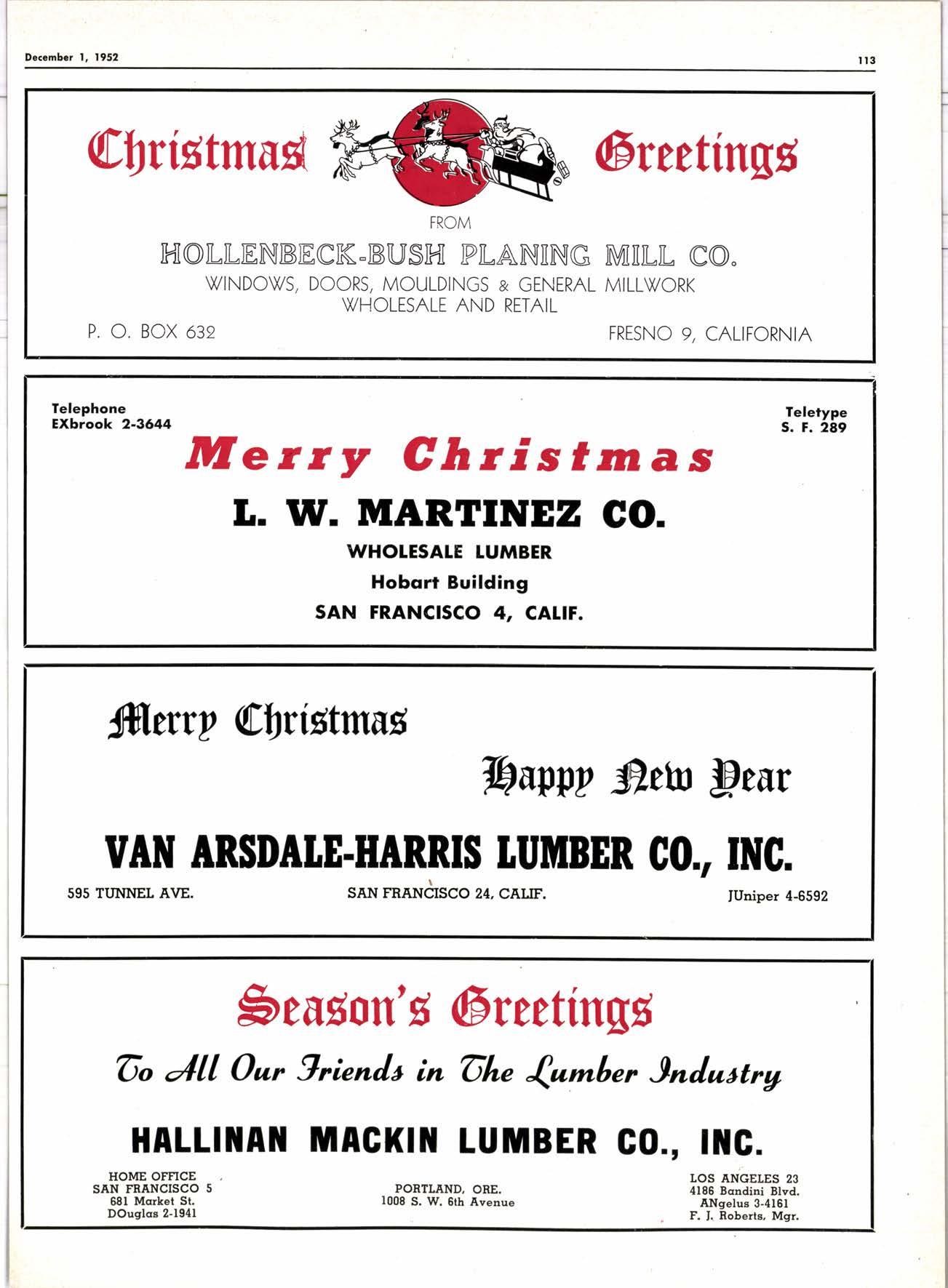
Awarded \(/est Coast Tree Farm Certificate
$500-the down payment, reducing the Post treasury to nickeLs and dimes. Christmas tree sales from the young growth that nature had produced, despite former fires, fortified the financing of the purchase.
The Christmas tree cuttings were done under forestry supervision, as were other Post activities on the land. Finally, another 20 acres were bought. This type of conservation manag'ement earned the 1952 tree farm certificate from the Industrial Forestry Association.
The certificate was awarded at a dinner meeting sponsored by the Women's Auxiliary of Post 76. Top executives of the Washington State Division of Forestry and the U. S. Soil Conservation Service and Forest Service, themselves veterans, attended with the officials who presented the award.
New Dealer Magazine
LeIt, Berncrrd Orell, Wqshingtoa Stcte Chiel Forester, looks on trs Howqrd Christicngon, Commcnder ol f,rlington, Wcshington, Americcn Legion Post No. 76, receives award oI West Cocret Tree Fqrnr Certilicqte. Cbarles S. Cowan, Mcncger oI Wcshington Forest Fire Agsocialion, presented the cerlilicqte lor the Industriql Forestry lssociction.
In 1949 Arlington, Washington, American Legion Post 76 Commander D. T. J. Ball and Legionnaire Will Hendrickson learned that 100 acres of Puget Sound tax-title property, all logging cutover was for sale. Some Douglas fir seed trees had been left from the old logging and succeeding fires and under improved protection, young tree growth was springing up.
Post 76 members fell in with plans for a memorial forest. Technicians of the U. S. Soil Conservation Service were asked to help. The agency and the West Coast Industrial Forestry Association, with private timber owners as members, had been cooperating in the development of three tracts near Arlington into a high school forest, with tree seedlings supplied by the West Coast Lumbermen's Association nursery. The State Division of Forestry, responsible for fire control, had an efficient organization in the area.
With this background, Post 76 went ahead with the Memorial Forest program, purchasing the 100 acres for forest products wrappings, toys,
Masonite Corporati,on has issued the first number of its new dealer magazine, Masonitems. to the dealers and wholesalers who sell the corporation's hardboards.
Printed in two colors, the first number carries six pages. The lead article is an illustrated two-page spread about a nerv Masonite display. It follows up the cover photo which shows the Selling Center in use at the Gee Lumber and Coal Co., Chicago.
Another major article makes suggestions for broadening the farm market. It challenges the readers with this statement: "If you are a dealer with 1,000 farms in your area, your prospects spend nearly one-half million dollars yearly for remodeling, repairs and new construction. How much of tl-ris business are you getting?"
Stories are published about the corporation's extensive advertising and publicity programs and about horv the Gee Lumber and Coal Co. finds profit in displays.
Masonitems u'ill be published bi-monthly. Its editor is Clarence Sutton, who works under the direction of Bradley P. Williams, sales promotion manager.
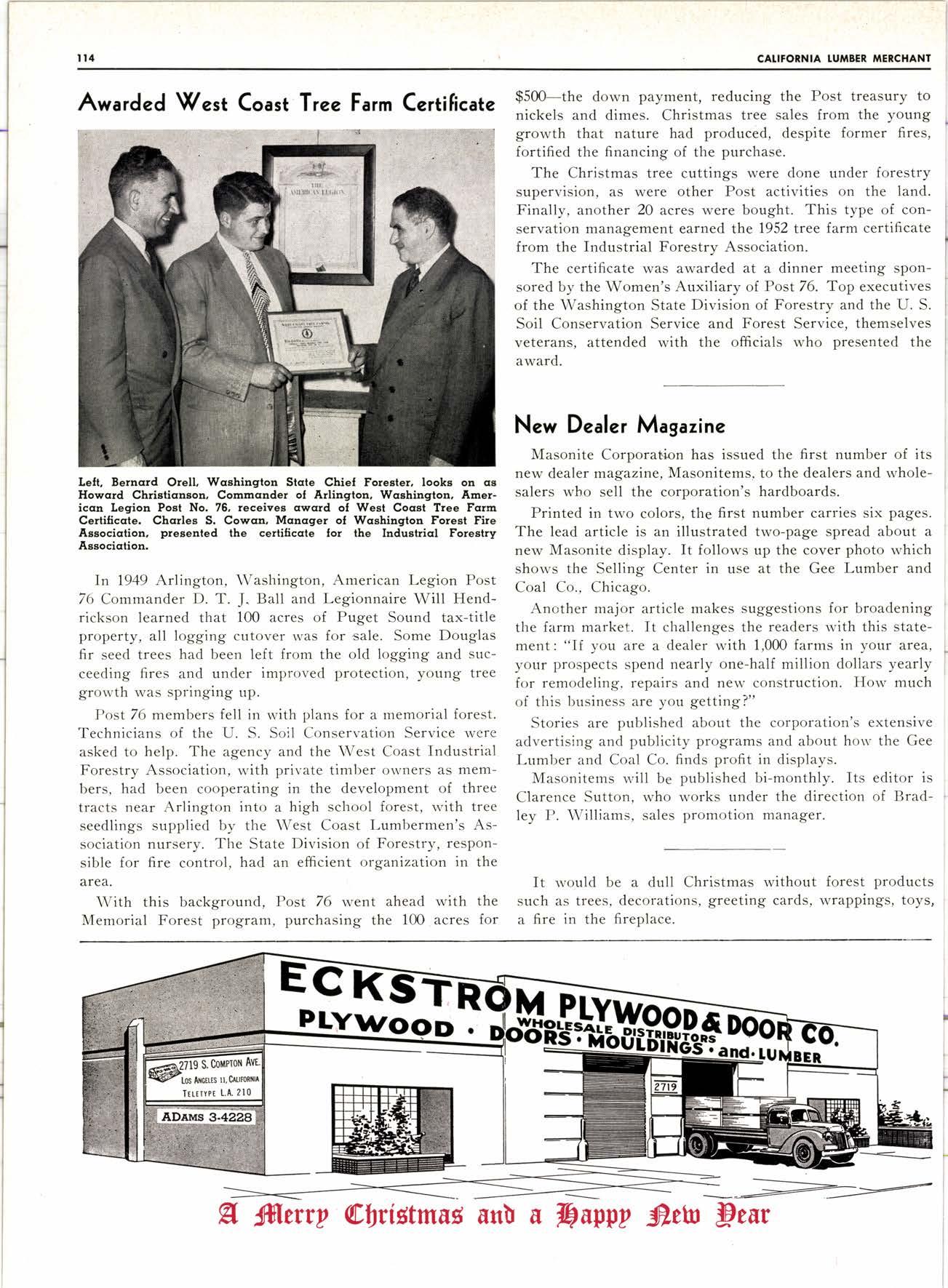
It rvould be a dull Christmas without such as trees, decorations, greeting cards, a fire in the fireplace.
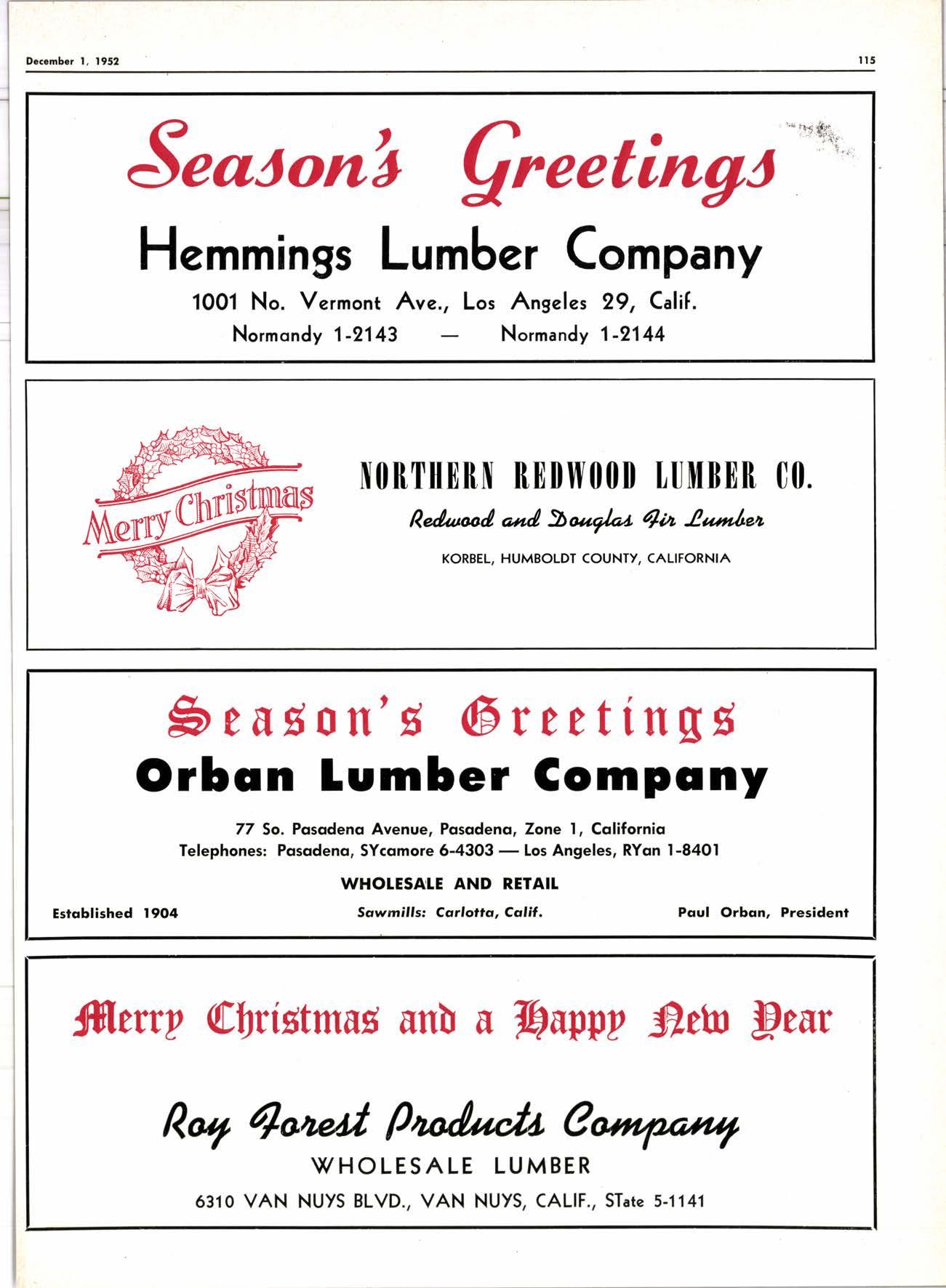
Named Full-Time Entomologist
Centralia, Wash.. Nov. l3 for U. S. War Bonds and McCowan says, "I developed sore ankles and a desire to cc:rre back to this part of the country after the war."
Damage from forest fires-perenniai destroyer of thousands of acres of woodlandshas been steadily reduced over the past sever:rl years through persistent public education, progressive forestry and logging methods and well-Jeveloped fire-prevention and fire-fighting programs.
"Any forester can appreciatr: the huge stands of timber out here," says McCowan, "but the informality and friendliness of the people is also a !;ig attraction."
A member of Phi Kappa Phi, scholastic honorary, and Xi Sigma Pi, forestry honorary, McCowan is married and the father of a daughter, 9 years, and a €on, 5 months. The family resides in Centralia.
Vcughcrn F. McCowqn the forest's enemies and are destroved bv insects
One result of this steady, if gradual, deciine in the number of acres lost to fire has been to put the limelight on a less spectacular but equally vicious enemy of the forest. Foresters today acknowledge insects as the greatest of concede that each year more trees than by fire
Weyerhaeuser Timber company, long concerned with the insect problem, gave recogniticrn to its seriousness recently by hiring a full-time entomoloqist, Veughan F. McCowan. McCowan. 33. works under the dire.:tion of Paul Lauterbach, Weyerhaeuser's research forester and manager of the firm's forestry research ofiice in Centralia. Spending considerable time in the field. he will study the characteristics and habits of insects l:ound on the company's tree farm,i in western Washington and Oregorr and work cooperatively with the forest insect laboratory of the U. S. bureau of entomology, Portlancl, Oregon, to develop effective and practical control. measures.
Among the insect enemies \fcQery3n will come to grips with are the Douglas fir beetlc, currelltly on a rampage of epidernic proportions in southwest Oregon, the spruce budworm, the hemlock looper, the ambrosia beetle and others.
Born and raised in Portland, Maine. McCowan is a 1951 graduate of the University of Mainc school of forestry. He :eceived his master's degree in entomology and forestry at the University of Michigan in .fune, 1952, and joined Weyerhaeuser the follcr'ving nronth.
New Fiscal Head of Forest Products Laboratory Announced
Bruce C. Strickler, Deputy Regional Fiscal Agent for the California Region of the Forest Service is being transferred and promoted to Fiscal Agent of the Forest Products Laboratory, at Madison, Wisconsin, effective December I,1952.
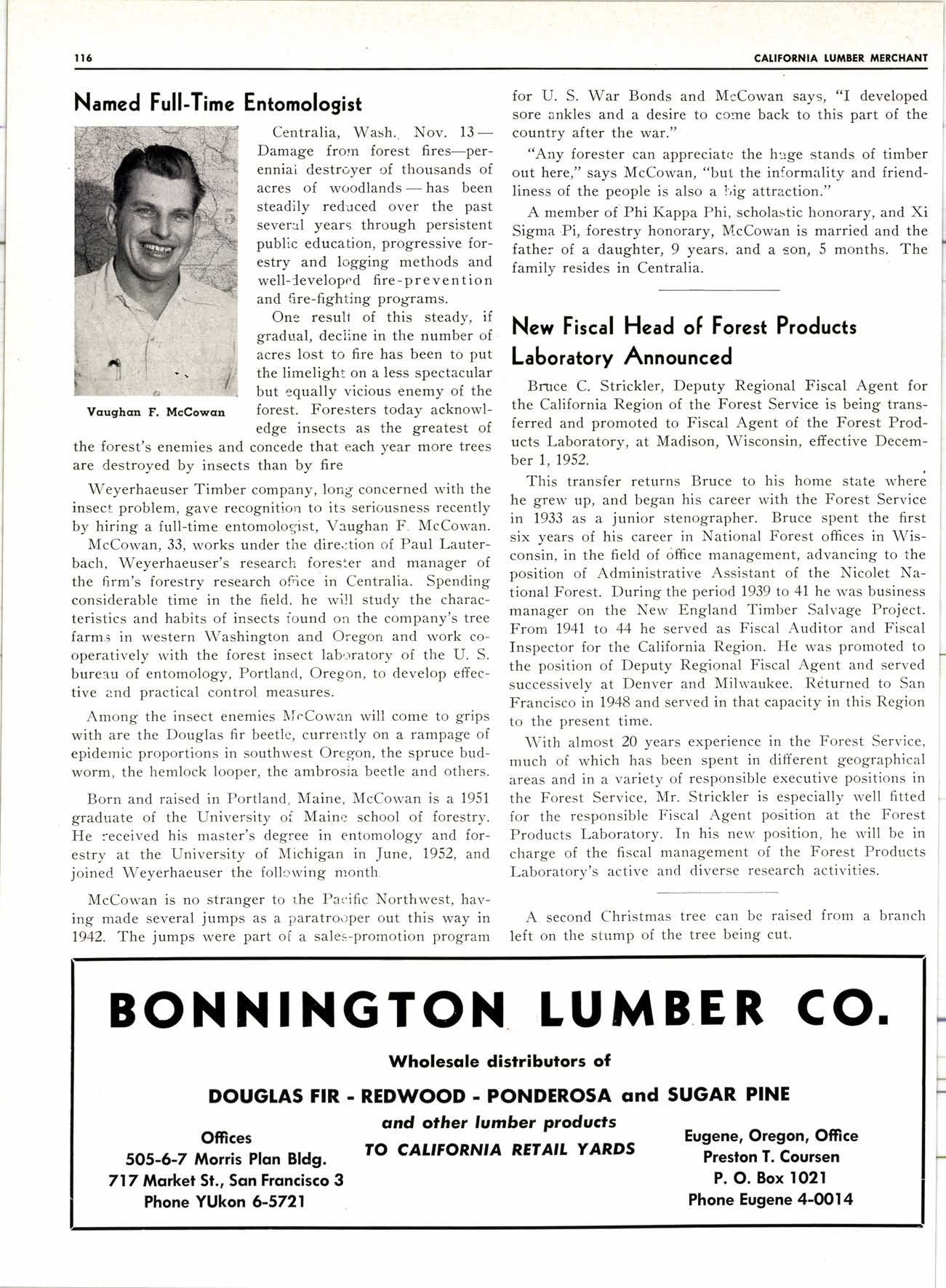
This transfer returns Bruce to his home state where he grew up, and began his career with the Forest Service in 1933 as a junior stenographer. Bruce spent the first six years of his career in National Forest offices in Wisconsin, in the field of <iffice management, advancing to the position of Administrative Assistant of the Nicolet National Forest. During the period 1939 to 41 he was business manager on the New England Timber Salvage Project. From 1941 to 44 he served as Fiscal Auditor and Fiscal Inspector for the California Region. He was promoted to the position of Deputy Regional Fiscal Agent and served successively at Denver and Milwaukee. Relturned to San Francisco in 1948 and served in that capacity in this Region to the present time.
With almost 20 years experience in the Forest Service, much of which has been spent in different geographical areas and in a variety of responsible executive positions in the Forest Service, Mr. Strickler is especially well fitted for the responsible Fiscal Agent position at the Forest Products Laboratory. In his new position, he r'vill be in charge of the fiscal management of the Forest Products Laboratory's active and diverse research activities.
McColvan is no stranger to r-he Par,ific Northwest, har'ing rnade several jumps as a paratror)p€r out this way in A second 1942. The jumps were part o[ a sales-promotion program left on the
Christmas tree can be raised froma branch stump of the tree being cut.

Hardwood Flooring In Strong Demand
Chicago, Nov. l2--The strong demand for hardwood flooring in the first nine months of..1952 r"eflects the firm hold which material has maintained on its popularity gains of the last few years, Secretary Henry H. Willins of the National Oak Flooring Manufacturers' Association reported today.
Shipments in the Southern and Appalachian regions, source of more than 90 per cent of the nation's supply, totaled over 720 million board feet in the first three quarters. They equalled the volume recorded for the corresponding period of 1951, which was the second biggest year in the industry's history.
There is a strong possibility, Willins said, that total1952 output will top last year's figure of more than 936 million board feet. Beginning in June and continuing through mid-October, the latest period for which figures were available, shipments consistently exceeded those in the similar periods last year. September output was 11 per cent higher than in the same month of 1951.
Should the last 10 weeks of this year see a continuation of the average weekly output in the preceding 12 months, the 1952 total would be nearly 965 million board feet, Willins said. The all-time record of. 1,025,762,00O feet was established in 1950, when home building topped the ex-
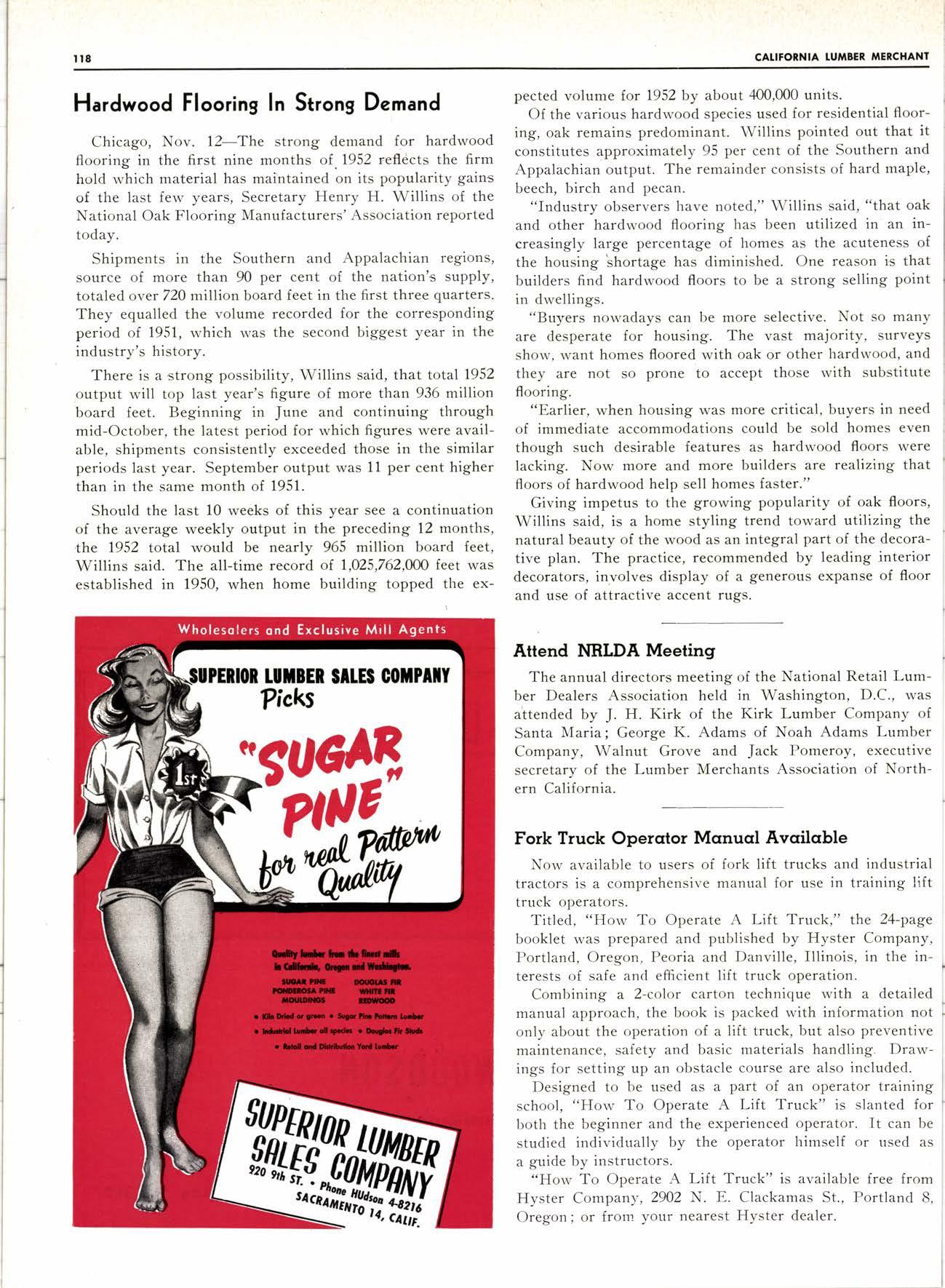
LUMEN $EI GOTPATT
Picks pected volume lor 1952 by about 4O0,000 units.
Of the various hardwood species used for residential flooring, oak remains predominant. Willins pointed out that it constitutes approximately 95 per cent of the Southern and Appalachian output. The remainder consists of hard maple, beech, birch and pecan.
"Industry observers have noted," Willins said, "that oak and other hardwood flooring has been utilized in an increasingly large percentage of homes as the acuteness of the housing 'shortage has diminished. One reason is that builders find hardwood floors to be a strong selling point in dwellings.
"Buyers nowadays can be more selective. Not so many are desperate for housing. Thevastmajority, surveys show, want homes floored with oak or other hardwood, and they are not so prone to accept those with substitute flooring.
"Earlier, when housing was more critical, buyers in need of immediate accommodations could be sold homes even though such desirable features as hardwood floors were lacking. Now more and more builders are realizing that floors of hardwood help sell homes faster."
Giving impetus to the growing popularity of oak floors, Willins said, is a home styling trend toward utilizing the natural beauty of the wood as an integral part of the decorative plan. The practice, recommended by leading .interior decorators, involves display of a generous expanse of floor and use of attractive accent rugs.
Attend NRTDA Meeting
The annual directors meeting of the National Retail Lumber Dealers Association held in Washington, D.C., was attended byJ.H. Kirk of the Kirk Lumber Company of Santa Maria; George K. Adams of Noah Adams Lumber Company, Walnut Grove and Jack Pomeroy, executive secretary of the Lumber Merchants Association of Northern California.
Fork Truck OpercrtorMcnucrl Avqilable
Now available to users of fork lift trucks and industrial tractors is a comprehensive manual for use in training lift truck operators.
Titled, "How To Operate A Lift Truck," the Z4-page booklet was prepared and published by Hyster Company, Portland, Oregon, Peoria and Danville, Illinois, in the interests of safe and efficient lift truck operation.
Combining a 2-color carton technique with a detailed manual approach, the book is packed with information not only about the operation of a lift truck, but aLso preventive maintenance, safety and basic materials handling. Drawings for setting up an obstacle course are also included.
Designed to be used as a part of an operator training school, "How To Operate A Lift Truck" is slanted for both the beginner and the experienced operator. It can be studied individually by the operator himself or used as a guide by instructors.
"How To Operate A Lift Truck" is available free from Hyster Company, 2m2 N. E. Clackamas St., Portland 8, Oregon; or from your nearest Hyster dealer.
